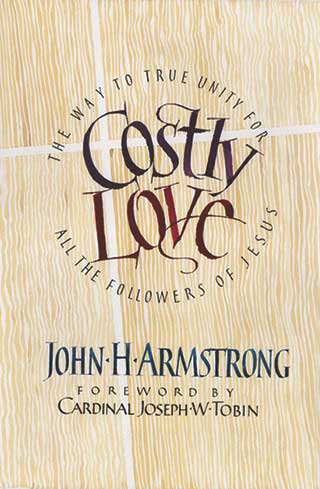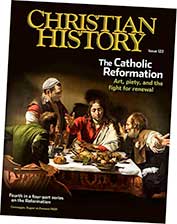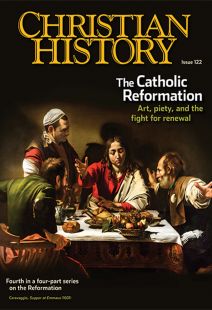The Catholic Reformation: Recommended Resources

BOOKS
Read about the Catholic Reformation in general in Outram Evennett, The Spirit of the Counter-Reformation (1968); John Olin, Catholic Reform from Cardinal Ximénes to the Council of Trent, 1495–1563 (1990); Marc Forster, The Counter-Reformation in the Villages (1992) and Catholic Revival in the Age of the Baroque (2001); Martin D. W. Jones, The Counter Reformation (1995); Robert Bireley, The Refashioning of Catholicism, 1450–1700 (1999); David Luebke, ed., The Counter Reformation (1999); A. D. Wright, The Early Modern Papacy (1999) and The Counter-Reformation (2005); John O’Malley, Trent and All That (2000); R. Po-Chia Hsia, World of Catholic Renewal, 1540–1770 (2005); James Corkery and Thomas Worcester, eds., The Papacy since 1500 (2010); and Thomas Mayer, Reforming Reformation (2012).
The story of Ignatius of Loyola and the Jesuits is told in James Brodrick, The Origin of the Jesuits (1940), The Progress of the Jesuits (1946), Saint Francis Xavier (1952), and Saint Ignatius Loyola (1956); George Schurhammer, Francis Xavier, His Life, His Times (1973); William Bangert, A History of the Society of Jesus (1986); Philip Caraman, Ignatius of Loyola (1990); John O’Malley, The First Jesuits (1993) and The Jesuits (2014); John Patrick Donnelly, Ignatius of Loyola (2004); Michael Ivens, An Approach to Saint Ignatius of Loyola (2008); and Thomas Worcester, ed., The Cambridge Companion to the Jesuits (2008). Loyola’s autobiography is A Pilgrim’s Journey, and his writings can be found in Ignatius of Loyola: Spiritual Exercises and Selected Works (1991) and Saint Ignatius of Loyola: Personal Writings (1996).
Read more about the Theatines in Paul Hallett, Catholic Reformer: The Life of St. Cajetan of Thiene (1955) and Theatine Spirituality (2005); the Capuchins in Thaddeus MacVicar and Charles McCarron, The Franciscan Spirituals and the Capuchin Reform (1987) and Paul Handbridge, The Capuchin Reform (2003); and the Carmelites in Peter-Thomas Rohrbach, Journey to Carith (1966); Christopher Wilson, ed., The Heirs of St. Teresa of Avila (2006); and Steven Payne, ed., The Carmelite Tradition (2011).
Trace Catholic attitudes toward the visual arts and piety in Franco Mormando, ed., Saints and Sinners (1999); John O’Malley et al., eds., The Jesuits: Cultures, Sciences, and the Arts, 1540–1773 (two volumes, 2000 and 2006); and Virginia Raguin, ed., Art, Piety, and Destruction in the Christian West, 1500–1700 (2010).
A good place to find the writings of Teresa of Ávila and John of the Cross is the Classics of Western Spirituality series. Biographies of the two include Silvano Giordano, God Speaks in the Night (1991); Kieran Kavanaugh, John of the Cross (2000); Cathleen Medwick, Teresa of Ávila (2001); Edward Howells, John of the Cross and Teresa of Avila (2002); Rowan Williams, Teresa of Avila (2004); Peter Tyler, John of the Cross (2010) and Teresa of Ávila (2014); and William Meninger, St. John of the Cross for Beginners (2014).
Order Christian History #122: The Catholic Reformation in print.
Subscribe now to get future print issues in your mailbox (donation requested but not required).
Other Catholic reformers have their stories told in Francois Charmot, Ignatius Loyola and Francis de Sales (1966); V. J. Matthews, Saint Philip Neri (1984); Wendy Wright, ed., Francis de Sales, Jane de Chantal (1988); Ronald Teske, ed., Robert Bellarmine (1988); Elisabeth Gleason, Gasparo Contarini (1993); Carol Thysell, The Pleasure of Discernment (2000); Patricia Francis Cholakian and Rouben Cholakian, Marguerite de Navarre (2016); Thomas Mayer, Reginald Pole (2007); John Edwards, Archbishop Pole (2014); Peter Matheson, Cardinal Contarini at Regensburg (2014); and John R. Cihak, ed., Charles Borromeo (2017).
Graphic novels for young people are even available about Teresa (God’s Troublemaker by Song-I Yun) and Neri (Laughing Saint by Hyon-Ju Yi)!
The Council of Trent is ably explained in John O’Malley’s Trent: What Happened at the Council (2013); for a more detailed look, consult Hubert Jedin’s multivolume The History of the Council of Trent (1951–1976). The Canons and Decrees and the Catechism of the Council of Trent are available in several English translations.
Read more about the Thirty Years’ War in C. V. Wedgwood’s classic The Thirty Years War (1938); Ronald Asch, The Thirty Years War (1997); Geoffrey Parker, The Thirty Years’ War (1997); Richard Bonney, The Thirty Years’ War 1618–1648 (2002); Peter Wilson, The Thirty Years’ War: Europe’s Tragedy (2009); and Tryntje Helfferich, The Essential Thirty Years’ War (2015).
The story of Arminius and his followers is told in Carl Bangs, Arminius (1985); Keith Stanglin, Arminius on the Assurance of Salvation (2007) and (with Thomas McCall) Jacob Arminius (2012); William den Boer, God’s Twofold Love (2010); and W. Stephen Gunter, Arminius and His Declaration of Sentiments (2012).
You can begin to trace the story of the Puritans in Perry Miller, Errand into the Wilderness (1956); Patrick Collinson, The Elizabethan Puritan Movement (1967); David Hall, Worlds of Wonder, Days of Judgment (1990); J. I. Packer, A Quest for Godliness (1990); John Coffey, Persecution and Toleration in Protestant England 1588–1689 (2002); Edmund Morgan, The Puritan Dilemma (2006); Leland Ryken, Worldly Saints (2010); and Richard Bailey, Race and Redemption in
Puritan New England (2014).
And, for starters in the ecumenical discussion, check out Louis Bouyer, The Spirit and Forms of Protestantism (1956); Mark Noll and Carolyn Nystrom, Is the Reformation Over? (1991); From Conflict to Communion (2013) by the Lutheran–Roman Catholic Commission on Unity; John Armstrong, Your Church Is Too Small (2010), The Unity Factor (2011), and Costly Love (2017); and Jerry Walls and Kenneth Collins, Roman But Not Catholic (2017).
CHRISTIAN HISTORY ISSUES
Read these past issues of Christian History online; some are still available for purchase:
• 8: Jonathan Edwards
• 41: The American Puritans
• 83: Mary
• 89: Richard Baxter and the English Puritans
• 118: The Peoples’ Refomation
• 120: Calvin, Councils, and Confessions
VIDEOS FROM VISION VIDEO
Videos on people and movements featured in this issue include The Agony and the Ecstasy; Catholicism; Common Ground; Ignatius of Loyola; the Pioneers of the Spirit episodes Loyola and Teresa of Ávila; Saint Philip Neri; Saints and Strangers; and This Changed Everything, the new award-winning presentation of the Reformation at 500 years.
WEBSITES
The main Jesuit website is Jesuit.org. Discalced Carmelites are at Carmelite.com (and Carmelite.org). Jesuit studies is a vast area: some websites especially helpful here are the Boston College Jesuit Bibliography; Jesuit Resource at Xavier University; Ignatian Spirituality from Loyola Press; and the Letters of Ignatius at Georgetown.
You may also find helpful some resource lists on Ignatius and early modern Catholicism and Reformation spirituality compiled by William Harmless, S.J. (They are part of bibliographies on every aspect of church history, well worth looking into.) For more on Galileo and the church, check out The Galileo Project. A list of resources on Christian ecumenism can be found at Act3Network; the Joint Declaration and From Conflict to Communion are also online.
As always, many of the Christian writings mentioned in this issue can be found at the Christian Classics Ethereal Library, at Project Gutenberg, and at the Modern History Sourcebook at Fordham University. Despite its title, the Post-Reformation Digital Library has many texts from this period available. The Wesley Center at Northwest Nazarene University has put Arminius’s works online. CH
This article is from Christian History magazine #122 The Catholic Reformation. Read it in context here!
Christian History’s 2015–2017 four-part Reformation series is available as a four-pack. This set includes issue #115 Luther Leads the Way; issue #118 The People’s Reformation; issue #120 Calvin, Councils, and Confessions; and issue#122 The Catholic Reformation. Get your set today. These also make good gifts.
By the editors
[Christian History originally published this article in Christian History Issue #122 in 2017]
Next articles
Three featured paintings
Three paintings that put Comenius’s life and times in perspective.
the editorsChurch History in Brief
A capsule overview of the movement Jesus started, seen mostly from a Western perspective.
Bruce L. ShelleyWho Am I
About the famous prison poem that we cannot post because of copyright considerations.
Dietrich BonhoefferSupport us
Christian History Institute (CHI) is a non-profit Pennsylvania corporation founded in 1982. Your donations support the continuation of this ministry
Donate





